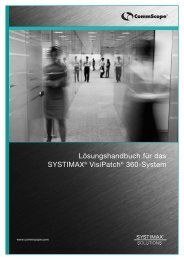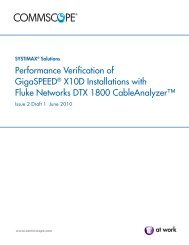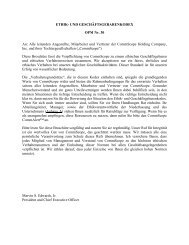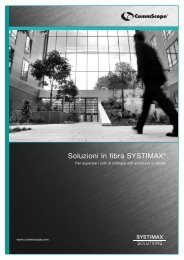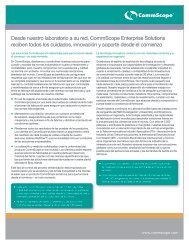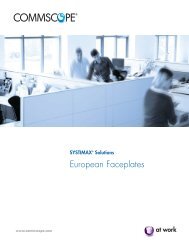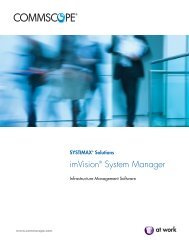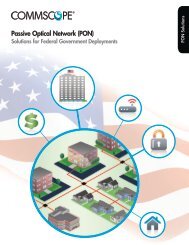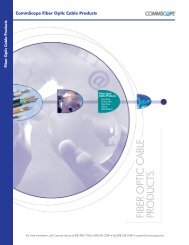CommScope® Enterprise Data Center Design Guide - Public ...
CommScope® Enterprise Data Center Design Guide - Public ...
CommScope® Enterprise Data Center Design Guide - Public ...
Create successful ePaper yourself
Turn your PDF publications into a flip-book with our unique Google optimized e-Paper software.
28<br />
www.commscope.com<br />
Fibre Channel<br />
Fibre Channel (FC) is the primary high-speed network technology for storage networking due to<br />
the protocol’s quality of service, reliable transport (lossless nature) and speed of data transfer.<br />
A fibre channel system can be set up as point-to-point, as an arbitrated loop, or in its most<br />
useful and common configuration, a switched fabric. In a fabric network, the switches manage<br />
the state of the fabric, providing optimized interconnections, and allow multiple pairs of ports<br />
to communicate simultaneously. A high availability (HA) configuration allows for a failure of one<br />
port to be “failed over” to a redundant path, and should not affect operation to the host or<br />
storage devices.<br />
Optical fiber is the typical media utilized for Fibre Channel, although a twisted pair option is<br />
allowed within the standard over shorter distances. FC is commonly available in speeds of 1,<br />
2, 4 and 8 gigabits. Although implementation of 1G speed is trending down, there may be<br />
some need of this lower speed to connect to mainframe storage using 1G ESCON networks.<br />
The industry is moving towards higher data rates now, with 16G speeds in development and<br />
32G speeds on the horizon. Although still in draft form, 16G speeds will likely be capable<br />
with OM3 fiber to distances of 100M, with a potential longer distance option utilizing OM4.<br />
Fibre Channel over Ethernet<br />
Fibre Channel over Ethernet (FCoE) is an attempt to simplify and converge the SAN and LAN<br />
networks at the data link layer. As Ethernet is becoming prevalent in the LAN and even moving<br />
out into the WAN or MAN space, it makes sense to consider a protocol that routes the SAN<br />
over the Ethernet. The FCoE standard was developed by INCITS T11 – The InterNational<br />
Committer for Information Technology Standards and completed in June 2009. FCoE<br />
recognizes that FC will continue to be a dominant storage protocol in the data center, while<br />
also providing for a simplified, consolidated I/O solution.<br />
To implement FCoE, the FC frame has to be encapsulated into an Ethernet frame. Using the<br />
layering models, the top layers of the FC, along with a new mapping layer, are stacked on top<br />
of the Ethernet MAC and physical layers to create the FCoE Frame. To preserve the lossless<br />
nature of FC, the optional PAUSE capability allowed by IEEE 802.3x Ethernet must be used to<br />
allow a busy receive port to send a control frame to the transmit port asking for it to pause<br />
transmission as well. Use of this feature circumvents the traditional Ethernet allowance of<br />
dropped packets. There are other requirements besides the “pause” mechanism required to<br />
make Ethernet lossless. These are part of the <strong>Data</strong> <strong>Center</strong> Bridging group of standards under<br />
development in IEEE. Finally the traditional point-to-point addressing of FC is not sufficient, as<br />
Ethernet does not form the same point-to-point connection. A MAC address has to be added as<br />
the first 2 fields of the FCoE frame in order to point to its Ethernet destination. This method of<br />
CEE – Converged Enhanced Ethernet – allows FCoE to exist and its lossless nature<br />
differentiates this from traditional Ethernet.<br />
FCoE is seen as complimentary to the movement towards virtualization. Hypervisors (platform<br />
allowing multiple operating systems to run on a host computer) need to provide guest operating<br />
systems with virtualized storage through a FC network infrastructure. Today it is cumbersome to<br />
move virtual servers to new equipment not just during initial employment, but over the lifetime of<br />
the system for optimization and maintenance purposes. IT managers often use 4, 6 or 8<br />
network adapters in critical applications to cover both Host Bus Adapters (HBA) and Network<br />
Interface Cards (NIC). FCoE enables the consolidation of both SANs and Ethernet traffic onto<br />
a single Converged Network Adapter (CNA), reducing the ever growing number of adapters<br />
required at the server level. FCoE combined with the advent of 10 Gigabit Ethernet (10 GE)<br />
fabrics grants companies the ability to consolidate their I/O, cables and adapters while at the<br />
same time increase the utilization of their servers through virtualization.



